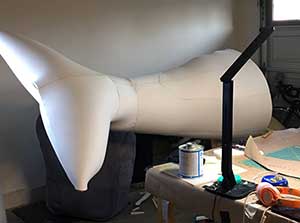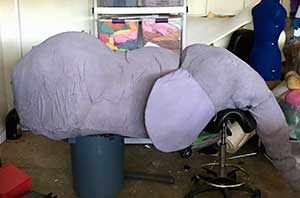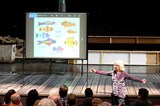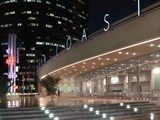By Beth Fhaner
Meet the Puppet Designer for "Amos & Boris"
Susan Gratch is a professor and head of design in the theater department at Occidental College. She also serves as the associate dean for the college in curriculum and academic support. Gratch designs scenery and lighting for many Occidental productions, and for theatres throughout the Los Angeles area and beyond. Additionally, she has designed several non-theatrical projects including two Olympic Games. Most recently, she lent her design expertise as the puppet designer for the musical Amos & Boris world premiere Theatre for Young Audiences show, Julianne Argyros Stage, May 18-June 3. Learn more about Gratch and her fascinating design work in this Q&A.

Boris' tail in production.

The elephant puppet in production.
Why are you drawn to puppets?
I have enjoyed puppets of various sorts since I was little. My sisters and I were given a set of marionettes—I was fascinated with how these wooden pieces could move realistically by manipulation of strings attached to them. I used hand puppets to help entertain my younger siblings when I baby sat.
As an adult, I began a career in scenic design and, on occasion, there were puppet-like objects that made their way into my designs. I really began to work with puppets when I worked with a team building the opening and closing ceremony parade puppets for the 1996 Atlanta Olympics. Since then, I’ve designed puppets large and small, highly stylized or very realistic.
What kind of puppets are you designing and how do you train the actors who will be wearing/operating them?
The puppets for Amos & Boris include two very large puppets that appear in the original book—Boris, the whale, and an elephant who makes an important, late appearance in the play. The writers for this adaptation have added characters to populate the ocean world that Amos discovers when he goes to sea: all sorts of fish and a seagull. The costume designer has created a couple of the sea creatures as well. For all of these puppets, the human actor is always visible, either “wearing” the puppet or operating it.
I work with the actors early in the rehearsal period to be sure that the movement of the puppets works for them and for the director. We make adjustments as needed so that the puppets can help us to tell the story clearly, that their characters are as fully functional as the human actors.
What’s the most delightful aspect of your work? And the most challenging?
I love working with Jessica Kubzansky, our director, and the other members of the design team as we imagine the world of the play early on. We started talking about this project in early November last year. Once we have a sense of style, color, scale and functionality, we have to adjust our visions to reality: how many actors we have to operate the puppets and budgets of time and money. On this project, the most challenging thing for me was making Boris big enough to be believable as a whale, but a small enough size that he could function on the stage with the other actors and the scenery.
Where do you find your inspiration when working on puppet design?
If, as in this case, the play is based on a book with illustrations, I begin there. Then, I look at images for inspiration about details. For this play, I did a lot of research on whale movement, whale tails, fins, eyes, looked at a lot of fish and elephants, oceans, fabrics and paper lanterns.
What kind of materials are used for the puppets?
Boris and the elephant have a shape made out of a closed-cell foam called L-200. It is then painted or covered with fabric. An understructure supports the shape and the mechanical devices that control movement are hidden inside, as are structural elements that will allow Amos to ride on Boris’ back. The fish puppets are largely made of translucent nylon fabric (kite fabric) with some lightweight internal structure and lighting added by our lighting designer, Rose Malone.
What’s a common misconception people have about the art of puppet design and creation?
Large processional puppets and many ancient traditions of puppet theatre are common around the world and the incorporation of puppets or puppet-like objects are becoming more common in theatrical performance in the U.S. However, many people first imagine puppets such as the Muppets or marionettes or children’s hand-puppets when I tell them I’m designing puppets for a project.
What have been some of your favorite design projects?
I loved being a part of a team building puppets for two Olympics—the Atlanta Olympics and the 2002 Salt Lake Olympics. In one year, I designed David Ives’ adaptation of The Liar, first for Occidental College and another for Portland for Artists Repertory Theater—two different directors, two very different stages, and the designs couldn’t have been more unlike! That was fun. I’ve had many favorite design projects, often working with Jessica Kubzansky—one of those was designing scenery for The Stinky Cheeseman here at SCR.
What can audiences expect when they come to see Amos & Boris?
I think that they can expect to be transported to a world that is filled with beauty, danger, unexpected help and friendship when needed, and an uplifting ending.


